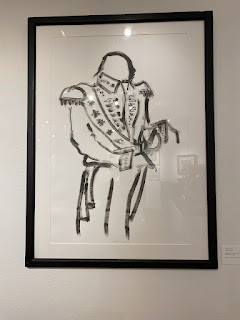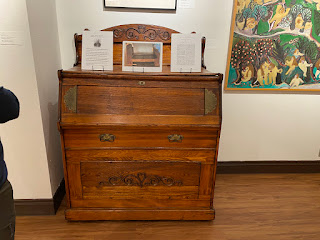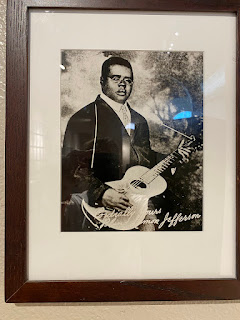Today we checked out another museum in downtown Dallas. The Dallas Museum of Art. Located at 1717 N. Harwood in Dallas, you can take the DART rail and use the St. Paul station to get there or, if you drive down there, the museum has a parking garage that charges a flat fee of $20. Entrance to the museum is free but you still need to get a ticket. The special exhibits cost extra. For $25, you can see them all.
Entrance to the Dallas Museum of Art from the garage side. The main entrance is from Flora Street.Even before you get inside, there's art! This is called "Genesis, the gift of Life" by Miguel Covarrubias.
Just a fun little exhibit where you can take your photo.
We got a map of the museum and most of the exhibits on the first floor (which the exception of the Keir Collection of Islamic Art) is considered a special exhibit and requires paid entrance. This is one of the exhibits that was there when we went. We did not visit this exhibit. We wanted to check out the permanent collection.As you walk down the hall on the first floor, there is a series of several panels like this. It's called "Rise into the Atmosphere" by Tiffany Chung. I thought it was pretty cool.
There is something for everyone at the Dallas Museum of Art. The second and third floors have various galleries that are included in the general admission. The docent recommended we start on the third floor and work our way down, which we did. This is called a "fuddling cup". It's from the mid-1600's. The three cups are attached and the trick is to drink all the liquid from one cup. At the bottom of the cups are holes that go from one cup to the other. I thought it was cool.
A portrait by an unknown artist. The subject is "probably" Edward Hyde, Lord of Cornbury in a dress. According to the note, this could be a form of slander during the reign of Queen Anne of England. He supposedly dress in women's clothing to symbolize his authority from the Queen. This guy was not a popular leader nor was he a particularly attractive lady.
This is a looking glass from the 1800's. John and I are in the mirror.
My favorite type of art is paintings. This one is called "Cotton Ball" by Otis Dozier. I like the how the colors just leap off the canvas.
It's not just paintings that they have here. They have furniture as well. This a "Vanderbilt console" and it was made in the late 1800's. This piece was commissioned for William H. Vanderbilt (of THE Vanderbilts) for the atrium in his home at 640 Fifth Avenue in New York.
This was one of John's favorite paintings. It's called "That Gentleman" by Andrew Wyeth. I liked it a lot as well. Behind John is a sculpture of Lead Belly by Michael G. Owen. Lead Belly was a folk musician and, apparently, a murderer! He was convicted of killing a relative in a dispute over a woman.There was a whole exhibit on nothing but silver. I liked the dressing table there in the middle.
This is a trumpet that was made between 300 - 200 BCE. That's right, before Christ! It's from Peru. I find ii amazing to have something that old!
There is also a section on Egyptian Art. This is a sarcophagus. It's the coffin of Horankh, from the 25th dynasty. It's made from a single tree trunk hollowed out in the shape of a human body wrapped in cloth.
A portrait by an unknown artist. The subject is "probably" Edward Hyde, Lord of Cornbury in a dress. According to the note, this could be a form of slander during the reign of Queen Anne of England. He supposedly dress in women's clothing to symbolize his authority from the Queen. This guy was not a popular leader nor was he a particularly attractive lady.
This is a looking glass from the 1800's. John and I are in the mirror.
My favorite type of art is paintings. This one is called "Cotton Ball" by Otis Dozier. I like the how the colors just leap off the canvas.
It's not just paintings that they have here. They have furniture as well. This a "Vanderbilt console" and it was made in the late 1800's. This piece was commissioned for William H. Vanderbilt (of THE Vanderbilts) for the atrium in his home at 640 Fifth Avenue in New York.
This was one of John's favorite paintings. It's called "That Gentleman" by Andrew Wyeth. I liked it a lot as well. Behind John is a sculpture of Lead Belly by Michael G. Owen. Lead Belly was a folk musician and, apparently, a murderer! He was convicted of killing a relative in a dispute over a woman.There was a whole exhibit on nothing but silver. I liked the dressing table there in the middle.
This is a trumpet that was made between 300 - 200 BCE. That's right, before Christ! It's from Peru. I find ii amazing to have something that old!
There is also a section on Egyptian Art. This is a sarcophagus. It's the coffin of Horankh, from the 25th dynasty. It's made from a single tree trunk hollowed out in the shape of a human body wrapped in cloth.
There's a section on African Art as well. I thought this was particularly cool. It's an Egungun costume that would be worn "at annual masquerades by a dancer who would spin around causing the panels to fly out in all directions".
As we made our way down to the second floor gallery we found some European Art. This is a painting by Edward Manet called "Portrait of Isabel Lemonnier with a muff".
This one is called "The River Seine in Paris" by Paul Signac. According to the plaque, this guy taught himself to paint after seeing an exhibit by everyone's favorite impressionist, Claude Monet.
And finally, this is a drawing by Henri de Toulouse-Lautrec called "Irish American Bar, Rue Royale, The Chap-Book". It's dated 1896. I don't know why but I love Toulouse-Lautrec.
As we made our way down to the second floor gallery we found some European Art. This is a painting by Edward Manet called "Portrait of Isabel Lemonnier with a muff".
This one is called "The River Seine in Paris" by Paul Signac. According to the plaque, this guy taught himself to paint after seeing an exhibit by everyone's favorite impressionist, Claude Monet.
And finally, this is a drawing by Henri de Toulouse-Lautrec called "Irish American Bar, Rue Royale, The Chap-Book". It's dated 1896. I don't know why but I love Toulouse-Lautrec.
By this time, we'd been here for a couple of hours and we ran out of gas. But this is just a sampling of the amazing art that you can see for FREE at the DMA. We'll definitely be back!






































